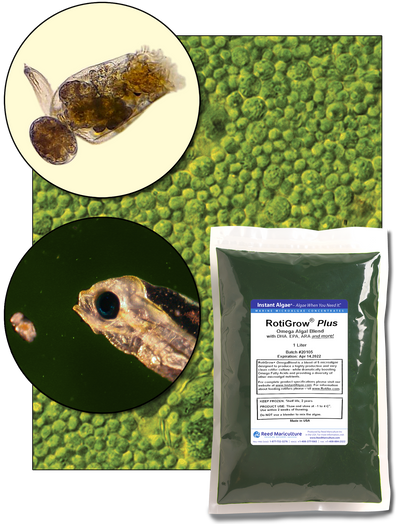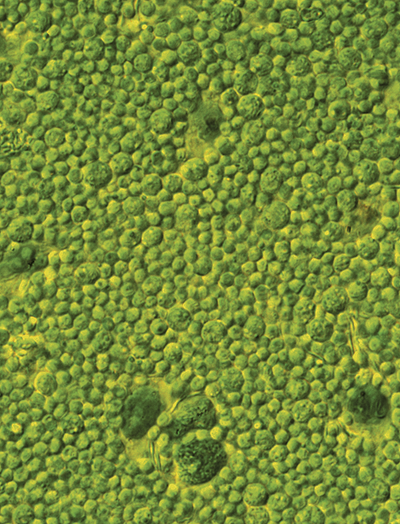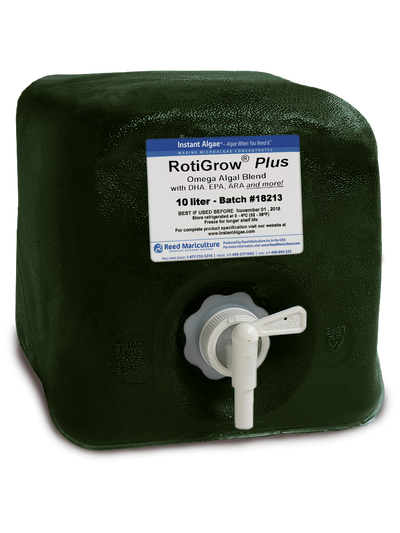



ROTIGROW PLUS™
A frozen blend of 6 microalgae for maximum Rotifer Production with full Rotifer Enrichment. High in carotenoids and phospholipids. 2-year frozen shelf life with a 3-week refrigerated shelf life.
Product Description
Applications & Benefits
Directions & Feeding
Directions
- Defrost frozen RotiGrow Plus slowly in a refrigerator overnight. RotiGrow Plus can be poured directly into the larval tank, but pre-diluting. (Note: 10 liter Cubitainers and cases may require 2 days defrosting)
- Mixing and screening are not necessary. DO NOT BLEND; it is unnecessary and may damage the algae cells.
- Feed according to the table below. Adjust dosage to meet the needs of your hatchery and larvae
Typical Feeding Protocol
Greenwater
Greenwater feeding rates are often correlated with rotifer stocking density. Optimal greenwater density ranges from 125,000 cells/ml to 625,000 cells per ml. This is equivalent to feeding Nanno at 2ml/1,000 liters to 10ml per 1,000 liters per feeding, fed 2 to 6 times a day. RotiGreen Iso and RotiGreen Omega are less dense and require more paste. The rotifers stocking densities in the examples above were 2 rotifers/ml and 15 rotifers/ml, respectively.
Feed 2-6 times per day
| Dose (ml/ 1,000 liters) | Cells/ml | |
|---|---|---|
| Light | 2.2 | 125,000 |
| Heavy | 11.0 | 625,000 |
Rotifer Production
* Feed rates based on 165micron l-type rotifer with a mass of 0.18g dry weight/million rotifers
Continuous
- Feed rate: 2ml/million rotifers – use rotifer count after harvest
- Typical harvest is 35-40% per day
- Feed 4-6 times per day
- Feed continuously for best results
- Divide daily feed rate by number of feedings
- If you harvest more or less rotifers per day, adjust feeding according to the table below
| Harvest Rate | Feed / million rotifers (ml) | Rotifers produced per liter Nanno 3600 |
|---|---|---|
| 25% | 1.2 | 320 |
| 35% | 1.9 | 320 |
| 50% | 3.4 | 320 |
Batch Production
- Feed rate: 2ml/million rotifers
- Feed 4-6 times per day or continuously
- Divide daily feed rate by number of feedings
- Feed continuously for best results
- For faster or slower growth rate, use table below
Batch Production Systems
| Rotifer Density (per ml) | ||||||
|---|---|---|---|---|---|---|
| RotiGrow Plus (feed per day per million rotifers) |
Day 0 | Day 1 | Day 2 | Day 3 | Rotifer Harvest (per liter of feed) |
Growth Rate (per day) |
| 1.4 ml | 500 | 706 | 996 | 1406 | 320 million | 41% |
| 2.0 ml | 500 | 795 | 1264 | 2010 | 320 million | 59% |
| 2.9 ml | 500 | 9910 | 1656 | 3013 | 320 million | 82% |
Nutritional Profile of Harvested Rotifers
| Rotigrow Plus | |
|---|---|
| Protein | 68% |
| Lipids | 10.50% |
| DHA | 17.0 mg/g * |
| EPA | 12.0 mg/g * |
| ARA | 1.9 mg/g * |
| HUFAs | 45 mg/g * |
| Polar Lipids | 54% |
| Sterols | 4.5% |
| Free Fatty Acids | 5.1% |
| Triglicerides | 36% |
* dry weight
Technical Information
| Packaging | 1-quart bottle, 1-liter bag, 10-liter cubitaner® |
|---|---|
| Storage | 2 years shelf life when frozen 3 week refrigerated shelf life after defrosting |
| Tip | If thawed and won't be used within 12 to 14 weeks, freeze in standard ice cube for 24 hours Store frozen cubes in plastic bag in freezer and then thaw before use |
| Physical Properties | |
|---|---|
| Appearance | Viscous green or brown Liquid |
| Algal cell size | 1.5 - 12 microns |
| Cell Density | Billion/ml |
| Algal Biomass | 148g Dry biomass/L |
| Composition of Dry Algal Biomass | |
|---|---|
| Protein | < 55.7% |
| Lipid | < 19.5% |
| EPA (% of Lipids) | 9.3% |
| DHA (% of Lipids) | 21.5% |
| ARA (% of Lipids) | 1.1% |
| Carbohydrate | < 19.0% |
| Ash | < 3.5% |
| Composition of Liquid Product | |
|---|---|
| Protein | > 8.4% |
| Lipids | > 2.8% |
| Carbohydrate | > 2.8% |
| Ash | < 5.0% |
| Moisture | < 81% |
| Microbial Specification | |
|---|---|
| Coliform Bacteria | 2 <0.3 mpn/mL |
| Salmonella | Negative |
| Known pathogenic marine bacteria | Negative |

